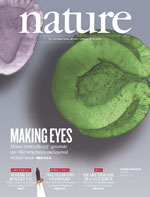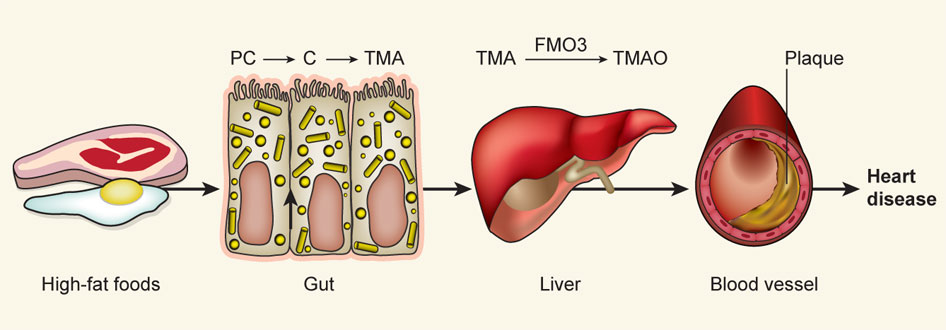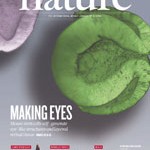 Diet, intestinal bacteria and liver metabolism to the generation of a chemical that promotes the build-up of arterial plaque and cardiovascular disease is the proposal in the alarmingly interesting paper published in the internationally respected Journal; Nature.[1] What we shout, how can two not simply innocuous but beneficial agents gang up to contribute to the cause of the world’s leading promoter of disease and death? Read on to find out.. Well, put together a lot of very bright people and a large sum of grant money and all sorts of quandaries appear in papers and set up interesting and complex relationships and discussions. Keen as I am to regard the role of microbiota as a great and generous gift horse, I am also aware that they are a double edged curse, a bit like marrying a beautiful and lovely spouse and then discovering her hidden family who have focused on maintaining a linear family tree for the last 4 generations!
Diet, intestinal bacteria and liver metabolism to the generation of a chemical that promotes the build-up of arterial plaque and cardiovascular disease is the proposal in the alarmingly interesting paper published in the internationally respected Journal; Nature.[1] What we shout, how can two not simply innocuous but beneficial agents gang up to contribute to the cause of the world’s leading promoter of disease and death? Read on to find out.. Well, put together a lot of very bright people and a large sum of grant money and all sorts of quandaries appear in papers and set up interesting and complex relationships and discussions. Keen as I am to regard the role of microbiota as a great and generous gift horse, I am also aware that they are a double edged curse, a bit like marrying a beautiful and lovely spouse and then discovering her hidden family who have focused on maintaining a linear family tree for the last 4 generations!
Heart Disease?
Our commensal bedfellows have already had the finger of accusation pointed at them for insulin resistance, obesity and non alcoholic fatty liver disease.[2],[3],[4] So why not find out if they may have an impact on atherosclerosis a condition in which fatty material collects along the walls of arteries. This fatty material thickens, hardens (forms calcium deposits), and may eventually block the arteries. Testing patients who had suffered a heart attack by measuring small molecules in their blood and comparing bloods from people who had not had a heart attack utilises technology employed in the new science of metabolomics. Three metabolites caught their attention – derived from a popular dietary lipid called phosphatidylcholine (also known as lecithin) they are: choline, betaine and trimethylamine N-oxide (TMAO). Once choline is released after phosphatidylcholine is acted upon by the enzyme phospholipase our resident bacteria – or in this case the studied mouse’s resident bacteria metabolise it into trimethylamine (TMA) a miserably fishy smelling gas that is taken to the liver where further master s of enzymatic reactions convert it into TMAO. The team state that in mice predisposed (so some genetic link also has to be identified) to atherosclerosis increased dietary choline increase atherosclerosis. Once mice had their bacteria removed by antibiotics TMAO was not detected in their blood.

So teasing out the implications the authors suggest a diet that is low in choline may actively reduce risk – so suggestions of reducing fatty foods fits with many other commentators suggestions.[5] Dean Ornish well known for his work advocates such a diet in his strategy. We could remove the bacteria as done in the mouse model and alter TMA production, but overuse of antibiotics has many other effects on gut colonies and may be a trigger for systemic inflammation due to dysbiosis which in turn may cause heart disease.[6] Or we could add bacteria in terms of probiotics, in one mouse model with humanized microbiome variations in output and contraction of TMAO was linked to different species of probiotic used.[7] Livers of mice fed with L. paracasei showed relative decreases in dimethylamine (DMA), trimethylamine (TMA), leucine, isoleucine, glutamine, and glycogen and increased levels of succinate and lactate. Mice supplemented with L. rhamnosus showed relative decreases in leucine and isoleucine and relative increases in succinate, TMA and trimethylamine-N-oxide (TMAO) in the liver compared to controls. The author’s state:
To our knowledge, the present studies are the first to identify a direct link between intestinal microflora, dietary PC and CVD risk. These results indicate that an appropriately designed probiotic intervention may serve as a therapeutic strategy for CVD.
Thus, in addition to the current clinical recommendation for a general reduction in dietary lipids, manipulation of commensal microbial composition may be a novel therapeutic approach for the prevention and treatment of atherosclerotic heart disease and its complications.
Comment
The interaction between genes, bacteria and food and their metabolic and immune effects on humans is a fascinating area of investigation and will drive probiotic studies to include strain specific studies on humans to obtain relevant clinical data and eventual treatment options.
References
[1] Wang Z, Klipfell E, Bennett BJ, Koeth R, Levison BS, Dugar B, Feldstein AE, Britt EB, Fu X, Chung YM, Wu Y, Schauer P, Smith JD, Allayee H, Tang WH, DiDonato JA, Lusis AJ, Hazen SL. Gut flora metabolism of phosphatidylcholine promotes cardiovascular disease. Nature. 2011 Apr 7;472(7341):57-63. View Abstract
[2] Bäckhed F, Ley RE, Sonnenburg JL, Peterson DA, Gordon JI. Host-bacterial mutualism in the human intestine. Science. 2005 Mar 25;307(5717):1915-20. Review. View Abstract
[3] Tsai F, Coyle WJ. The microbiome and obesity: is obesity linked to our gut flora? Curr Gastroenterol Rep. 2009 Aug;11(4):307-13. Review. View Abstract
[4] Dumas ME, Barton RH, Toye A, Cloarec O, Blancher C, Rothwell A, Fearnside J, Tatoud R, Blanc V, Lindon JC, Mitchell SC, Holmes E, McCarthy MI, Scott J, Gauguier D, Nicholson JK. Metabolic profiling reveals a contribution of gut microbiota to fatty liver phenotype in insulin-resistant mice. Proc Natl Acad Sci U S A. 2006 Aug 15;103(33):12511-6. Epub 2006 Aug View Abstract
[5] Zeisel SH, Mar MH, Howe JC, Holden JM. Concentrations of choline-containing compounds and betaine in common foods. J Nutr. 2003 May;133(5):1302-7. Erratum in: J Nutr. 2003 Sep;133(9):2918. View Abstract
[6] Fava F, Lovegrove JA, Gitau R, Jackson KG, Tuohy KM. The gut microbiota and lipid metabolism: implications for human health and coronary heart disease. Curr Med Chem. 2006;13(25):3005-21. Review. View Abstract
[7] Martin FP, Wang Y, Sprenger N, Yap IK, Lundstedt T, Lek P, Rezzi S, Ramadan Z, van Bladeren P, Fay LB, Kochhar S, Lindon JC, Holmes E, Nicholson JK. Probiotic modulation of symbiotic gut microbial-host metabolic interactions in a humanized microbiome mouse model. Mol Syst Biol. 2008;4:157. Epub 2008 Jan 15. View Paper
Probiotics and Lecithin cause heart disease?
Diet, intestinal bacteria and liver metabolism to the generation of a chemical that promotes the build-up of arterial plaque and cardiovascular disease is the proposal in the alarmingly interesting paper published in the internationally respected Journal Nature.[1] What we shout how can two not simply innocuous but beneficial agents gang up to contribute to the cause of the world’s leading promoter of disease and death.
Well put together a lot of very bright people and a large sum of grant money and all sorts of quandaries appear in paper and set up interesting and complex relationships – keen as I am to regard the role of microbiota as a great and generous gift horse, I am also aware that they are a double edged curse, a bit like marrying a beautiful and lovely spouse and then discovering her hidden family who have focused on maintaining a linear family tree for the last 4 generations.
Our commensal bedfellows have already had the finger of accusation pointed at them for insulin resistance, obesity and non alcoholic fatty liver disease.[2],[3],[4] So why not find out if they may have an impact on atherosclerosis a condition in which fatty material collects along the walls of arteries. This fatty material thickens, hardens (forms calcium deposits), and may eventually block the arteries.
Testing patients who had suffered a heart attack by measuring small molecules in their blood and comparing bloods from people who had not had a heart attack utilises technology employed in the new science of metabolomics.
Three metabolites caught their attention – derived from a popular dietary lipid called phosphatidylcholine (also known as lecithin) they are: choline, betaine and trimethylamine N-oxide (TMAO).
Once choline is released after phosphatidylcholine is acted upon by the enzyme phospholipase our resident bacteria – or in this case the studied mouse’s resident bacteria metabolise it into trimethylamine (TMA) a miserably fishy smelling gas that is taken to the liver where further master s of enzymatic reactions convert it into TMAO.
The team state that in mice predisposed (so some genetic link also has to be identified) to atherosclerosis increased dietary choline increase atherosclerosis. Once mice had their bacteria removed by antibiotics TMAO was not detected in their blood.
So teasing out the implications the authors suggest a diet that is low in choline may actively reduce risk – so suggestions of reducing fatty foods fits with many other commentators suggestions.[5] Dean Ornish well known for his work advocates such a diet in his strategy.
We could remove the bacteria as done in the mouse model and alter TMA production, but overuse of antibiotics has many other effects on gut colonies and may be a trigger for systemic inflammation due to dysbiosis which in turn may cause heart disease.[6]
Or we could add bacteria in terms of probiotics, in one mouse model with humanized microbiome variations in output and contraction of TMAO was linked to different species of probiotic used.[7] Livers of mice fed with L. paracasei showed relative decreases in dimethylamine (DMA), trimethylamine (TMA), leucine, isoleucine, glutamine, and glycogen and increased levels of succinate and lactate. Mice supplemented with L. rhamnosus showed relative decreases in leucine and isoleucine and relative increases in succinate, TMA and trimethylamine-N-oxide (TMAO) in the liver compared to controls.
The author’s state:
To our knowledge, the present studies are the first to identify a direct link between intestinal microflora, dietary PC and CVD risk. These results indicate that an appropriately designed probiotic intervention may serve as a therapeutic strategy for CVD.
Thus, in addition to the current clinical recommendation for a general reduction in dietary lipids, manipulation of commensal microbial composition may be a novel therapeutic approach for the prevention and treatment of atherosclerotic heart disease and its complications.
Comment
The interaction between genes, bacteria and food and their metabolic and immune effects on humans is a fascinating area of investigation and will drive probiotic studies to include strain specific studies on humans to obtain relevant clinical data and eventual treatment options.
[1] Wang Z, Klipfell E, Bennett BJ, Koeth R, Levison BS, Dugar B, Feldstein AE, Britt EB, Fu X, Chung YM, Wu Y, Schauer P, Smith JD, Allayee H, Tang WH, DiDonato JA, Lusis AJ, Hazen SL. Gut flora metabolism of phosphatidylcholine promotes cardiovascular disease. Nature. 2011 Apr 7;472(7341):57-63. View Abstract
[2] Bäckhed F, Ley RE, Sonnenburg JL, Peterson DA, Gordon JI. Host-bacterial mutualism in the human intestine. Science. 2005 Mar 25;307(5717):1915-20. Review. View Abstract
[3] Tsai F, Coyle WJ. The microbiome and obesity: is obesity linked to our gut flora? Curr Gastroenterol Rep. 2009 Aug;11(4):307-13. Review. View Abstract
[4] Dumas ME, Barton RH, Toye A, Cloarec O, Blancher C, Rothwell A, Fearnside J, Tatoud R, Blanc V, Lindon JC, Mitchell SC, Holmes E, McCarthy MI, Scott J, Gauguier D, Nicholson JK. Metabolic profiling reveals a contribution of gut microbiota to fatty liver phenotype in insulin-resistant mice. Proc Natl Acad Sci U S A. 2006 Aug 15;103(33):12511-6. Epub 2006 Aug View Abstract
[5] Zeisel SH, Mar MH, Howe JC, Holden JM. Concentrations of choline-containing compounds and betaine in common foods. J Nutr. 2003 May;133(5):1302-7. Erratum in: J Nutr. 2003 Sep;133(9):2918. View Abstract
[6] Fava F, Lovegrove JA, Gitau R, Jackson KG, Tuohy KM. The gut microbiota and lipid metabolism: implications for human health and coronary heart disease. Curr Med Chem. 2006;13(25):3005-21. Review. View Abstract
[7] Martin FP, Wang Y, Sprenger N, Yap IK, Lundstedt T, Lek P, Rezzi S, Ramadan Z, van Bladeren P, Fay LB, Kochhar S, Lindon JC, Holmes E, Nicholson JK. Probiotic modulation of symbiotic gut microbial-host metabolic interactions in a humanized microbiome mouse model. Mol Syst Biol. 2008;4:157. Epub 2008 Jan 15. View Paper






2 Comments. Leave new
PS. I took lecithin capsules for years prior to the serines. My husband used soymilk and soy products generously for years. I was shocked to find out in the article that phosphatidylcholine was lecithin.
A well knowned naturopath in my area prescribed a Lipotropic supplment for my NAFL since traditional medecine have no treatment available. Took it for one year then had an artery blockage that took me to ER and caused an infactus. Exactly as explained in this article. Funny that in traditional medecine and homeopathy, it would seem the right hand in unaware of what the left hand is doing.